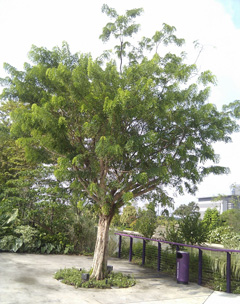 |
|
https://edibleplants.org/ |
 |
| https://edibleplants.org/ |
Translate this page:
Summary
Dalbergia oliveri is a deciduous tree that grows about 30 m in height and with an open, spreading crown. It is commonly found in Southeast Asia, specifically in Myanmar, Thailand, Laos, Cambodia, and Vietnam. It is highly valued for its red lumber used in making furniture, cabinets, and handicrafts among others. It is considered as an endangered species due to overharvesting.
Physical Characteristics

 Dalbergia_oliveri is a deciduous Tree growing to 23 m (75ft) by 20 m (65ft) at a slow rate.
Dalbergia_oliveri is a deciduous Tree growing to 23 m (75ft) by 20 m (65ft) at a slow rate.
See above for USDA hardiness. It is hardy to UK zone 10. The flowers are pollinated by Insects.
Suitable for: light (sandy), medium (loamy) and heavy (clay) soils and prefers well-drained soil. Suitable pH: mildly acid, neutral and basic (mildly alkaline) soils. It can grow in semi-shade (light woodland) or no shade. It prefers moist soil.
UK Hardiness Map
US Hardiness Map
Synonyms
Dalbergia laccifera Laness. Dalbergia prazeri Prain
Plant Habitats
Edible Uses
References More on Edible Uses
Medicinal Uses
Plants For A Future can not take any responsibility for any adverse effects from the use of plants. Always seek advice from a professional before using a plant medicinally.
None known
References More on Medicinal Uses
The Bookshop: Edible Plant Books
Our Latest books on Perennial Plants For Food Forests and Permaculture Gardens in paperback or digital formats.

Edible Tropical Plants
Food Forest Plants for Hotter Conditions: 250+ Plants For Tropical Food Forests & Permaculture Gardens.
More

Edible Temperate Plants
Plants for Your Food Forest: 500 Plants for Temperate Food Forests & Permaculture Gardens.
More

More Books
PFAF have eight books available in paperback and digital formats. Browse the shop for more information.
Shop Now
Other Uses
Other Uses: The heartwood is a dark red-brown; the sapwood white[ 146 ]. The wood is close-grained, hard, heavy, and resistant to the attacks of termites. It has an attractive, veined structure and is easy to polish. It is often used for making quality furniture, luxury cabinets, art and handicrafts etc, as well as the handles of agricultural implements[ 404 , 598 ].
Special Uses
References More on Other Uses
Cultivation details
Young trees are fairly shade tolerant, but older trees prefer a sunny position[ 404 ]. Members of this genus generally prefer a fertile, loam soil[ 200 ]. A slow-growing tree[ 404 ]. Although many species within the family Fabaceae have a symbiotic relationship with soil bacteria, this species is said to be devoid of such a relationship and therefore does not fix atmospheric nitrogen[ 755 ].
References Carbon Farming Information and Carbon Sequestration Information
Temperature Converter
Type a value in the Celsius field to convert the value to Fahrenheit:
Fahrenheit:
The PFAF Bookshop
Plants For A Future have a number of books available in paperback and digital form. Book titles include Edible Plants, Edible Perennials, Edible Trees,Edible Shrubs, Woodland Gardening, and Temperate Food Forest Plants. Our new book is Food Forest Plants For Hotter Conditions (Tropical and Sub-Tropical).
Shop Now
Plant Propagation
Like many species within the family Fabaceae, once they have been dried for storage the seeds of this species may benefit from scarification before sowing in order to speed up germination. This can usually be done by pouring a small amount of nearly boiling water on the seeds (being careful not to cook them!) and then soaking them for 12 - 24 hours in warm water. By this time they should have imbibed moisture and swollen - if they have not, then carefully make a nick in the seedcoat (being careful not to damage the embryo) and soak for a further 12 hours before sowing[ K ].
Other Names
If available other names are mentioned here
Neang Nuon, Mai Ching Chan, Mai Kham Phii, tamalan, Burmese Rosewood, Laos Rosewood, Asian Rosewood.
Native Range
TROPICAL ASIA: India (Arunachal Pradesh), Myanmar, Thailand, Vietnam, Malaysia
Weed Potential
Right plant wrong place. We are currently updating this section.
Please note that a plant may be invasive in one area but may not in your area so it’s worth checking.
Conservation Status
IUCN Red List of Threatened Plants Status : Status: Endangered A1cd

Growth: S = slow M = medium F = fast. Soil: L = light (sandy) M = medium H = heavy (clay). pH: A = acid N = neutral B = basic (alkaline). Shade: F = full shade S = semi-shade N = no shade. Moisture: D = dry M = Moist We = wet Wa = water.
Expert comment
Author
Gamble ex Prain
Botanical References
Links / References
For a list of references used on this page please go here
A special thanks to Ken Fern for some of the information used on this page.
Readers comment
| Add a comment |
|
If you have important information about this plant that may help other users please add a comment or link below. Only comments or links that are felt to be directly relevant to a plant will be included. If you think a comment/link or information contained on this page is inaccurate or misleading we would welcome your feedback at [email protected]. If you have questions about a plant please use the Forum on this website as we do not have the resources to answer questions ourselves.
* Please note: the comments by website users are not necessarily those held by PFAF and may give misleading or inaccurate information.
To leave a comment please Register or login here All comments need to be approved so will not appear immediately.
|
Subject : Dalbergia_oliveri
|
|
|
|